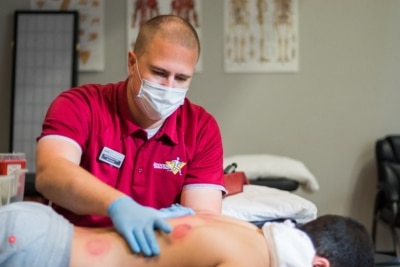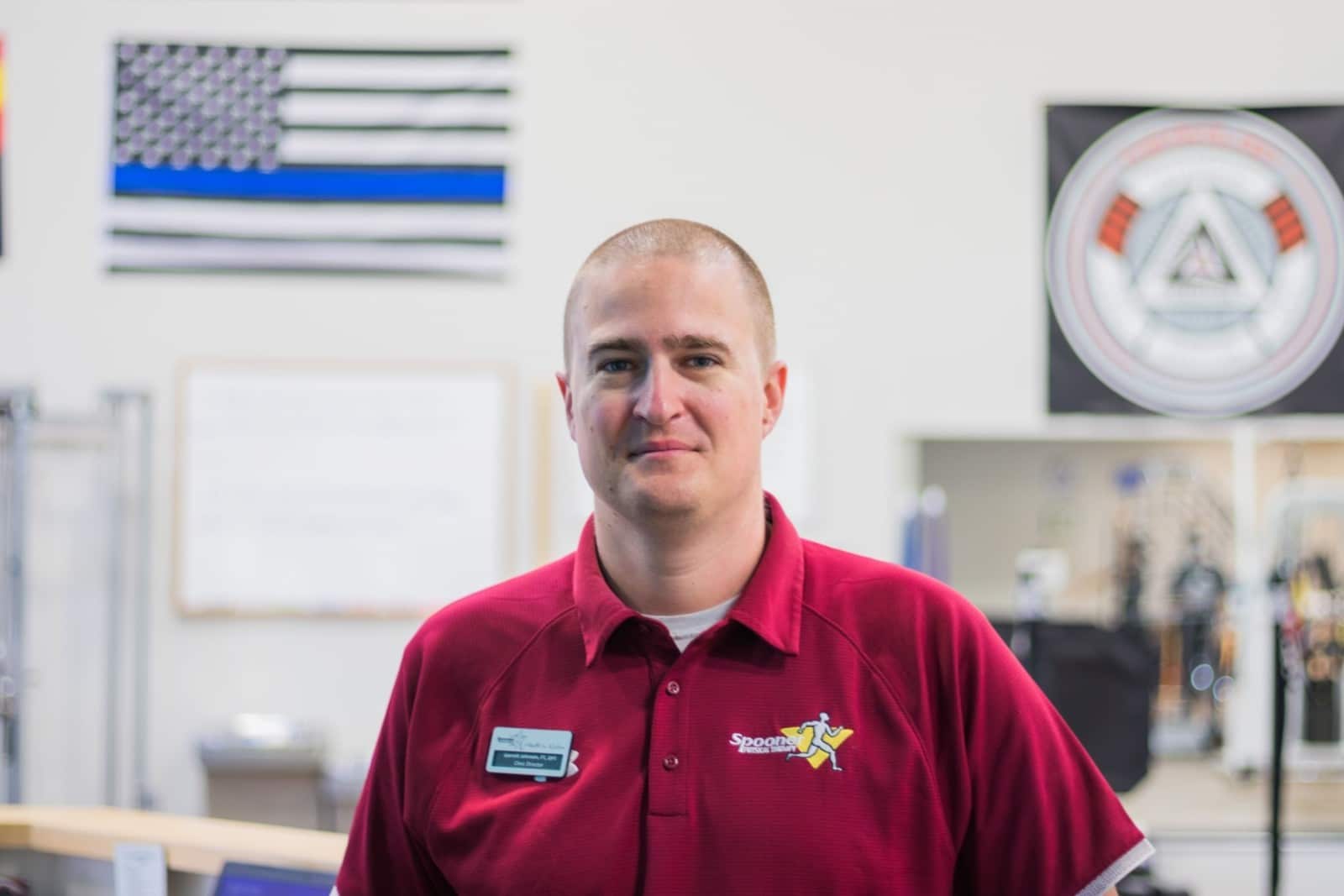Sometimes, the paths we take to get to where we’re at are more traditional, simple, and straightforward. Other times, these paths take so many twists and turns that when we look back, it’s astonishing that we can still remember anything about it.
We recently sat down to talk with Garrett Johnson, PT, DPT, Clinic Director at Spooner. Garrett joined the military in high school, worked as a police officer in two different states, and is now a physical therapist and clinic directorial therapist. Join us as we learn more about the many paths of Garrett’s journey at Spooner and how he became the physical therapist he is today!
Did you always want to be a PT?
Not exactly. When I first started undergrad, I was already in the Army and was on track to go to flight school and become a helicopter pilot. My college major was initially Athletic Training and Pre-Physical Therapy, but because I was planning to spend at least four years in the military after college, I ended up switching my major to Colonial and Revolutionary War American History. After receiving my degree, I had an old injury resurface, which forced me to change course.
How did the injury occur?
In military training, I got hit with shrapnel from an explosive device. It left a cut about ten inches long across the back of my shoulder blade. Of course, being a 20-year-old male, I didn’t do much about it. The medics out in the field stopped the bleeding, and in my head, everything was fine. I never actually saw a doctor; I just iced it and rested for a couple of days. I was still able to move it, so I figured everything was okay…
Unfortunately, the biomechanics of my shoulder were never quite the same after that. About a year and a half after the initial injury, I was doing some pushups during military fitness training, and my shoulder just completely fell out of place. It hurt so bad I must have blacked out for about 5 minutes cause I don’t remember much about it.
After resetting my own shoulder, undergoing several MRIs, and completing multiple bouts of physical therapy, my shoulder wasn’t showing much improvement. Eventually, I was medically discharged from the Army.
What did your journey look like after being medically discharged from the military?
Well, first off, I saw a doctor who was able to give me some answers and solutions to my shoulder issues. After a successful surgery and another round of physical therapy, my shoulder was in a much better place. That whole experience kind of rekindled my initial interest in pursuing a career in physical therapy.
After rehabbing my shoulder, I spent about 3 years in law enforcement as a police officer in Montana and later Alaska. Then, I jumped into the healthcare field as a Registered Sleep Technician for another few years. While working there, I continued to study and complete coursework required for physical therapy school and eventually was accepted into the program at the University of Montana.
What was your PT School experience like?
A big part of physical therapy schooling is the clinical rotations you get to be a part of, and I had amazing experiences at each of them:
1st clinical rotation – I spent time at one of the VA (Veterans’ Administration) clinics in town, which was perfect for me because those were my people. I had a good clinical instructor who had actually gone to my school, so he knew what we were learning and where I should be. That’s where my first big interest in prosthetics (which I now specialize in at Spooner) came from because a fair portion of our patients were amputees.
2nd clinical rotation – I spent 5 weeks at a small-town rural hospital in Montana, which consisted of 18 beds total! That was fun. My clinical instructor and I were in charge of taking care of everybody on the hospital floor. At the end of my 5 weeks, I was the one going around making the daily PT recommendations for everyone: Who’s ready to be discharged? Who needs more work? Who’s safe to go home? Who needs to go to an extended care facility? I got to collaborate with the doctors and hospitalists, surgeons, nurses, social workers, OBGYNs, and occupational therapists on the patient’s plan of care, which was such a neat experience!
3rd clinical rotation – I worked at an in-patient rehab facility. Essentially, our job was to get people home if they weren’t ready after their hospital stay. During my time there, I was able to see and treat a wide range of patient circumstances, such as amputees, neurological conditions, spinal cord injuries, and much more.
What was your biggest takeaway from your clinical experiences?
The biggest realization I had was that oftentimes in school, they would talk about what’s normal; however, when you get into the real world, you start to understand that there is no such thing. There may be a normal for each individual, but there isn’t one normal that everyone will fit into.
I learned that I have to be very adaptable, not have a lot of ego, and need to have a wide range of skill sets and tools. I’m not always going to run into people who fit into what’s normal, so having that flexibility and ability to adapt to meet that patient’s needs is one of the biggest things that I learned in my clinical experiences.
It was challenging but a great learning experience. If I hadn’t been pushed in that way, I don’t think I would be as proficient as I am today. If I saw nothing but simple surgeries and patients that fit specific protocols, I would have come out of PT school with the attitude that everyone’s going to fit inside this little box. I was very fortunate to have the experiences I had.
What did you do after you graduated PT school?
I moved to Arizona with my wife and two kids. My wife was looking into getting her PhD from Arizona State University, and I was able to find a job close to home. We also had friends and family living in Arizona at the time. So, the move provided us with a solid support structure and the flexibility to do what was best for us.
When did you start working for Spooner?
I started working for Spooner in January of 2018. From my first conversation with Tim Spooner, I just felt like we were on the same wavelength. Everybody always talks about “patient-centeredness.” Some physical therapy companies feel like they are business first, and other places feel like they’re actually living by that patient-first mindset. Spooner is definitely that place! They are going to do the right things for the patients, and that’s going to drive the business, not the other way around. Their priorities are in the right place, and I knew it was a place where I was going to fit in.
I started as a staff therapist in our North Mesa clinic and then was promoted to Clinic Director just a month or so later.
What was the transition from a staff therapist to a Clinic Director like?
Because we were such a small clinic when I took over, the challenge wasn’t, “How am I going to manage this group?” It was, “How are we going to grow this team?” From March 2018 to January 2020, we went from two to five therapists, which was a lot of fun! We definitely expanded more quickly than I thought we would, and there were some growing pains that went along with that.
I felt like I was just barely keeping up, but it was a really good learning experience on how to make those transitions smooth while expanding the team and bringing on new team members – as well as managing schedules and different attitudes.
In January 2020, I transitioned from our North Mesa clinic and became the Clinic Director of our Mesa Gateway location.
What’s been your favorite memory at Spooner thus far?
It is kind of bittersweet, but the staff meeting where we announced that I’d be transferring clinics is one of my favorite memories. There I am, standing in front of the clinic, just looking at this group of 14-15 people. I told them right there, “A year and a half ago, there were 5 of us.”
It said a lot about that group of people and what we had built together. Even though I was leaving, I was leaving a solid team with a successful and strong clinic.
What do you like most about being a PT?
 I got into law enforcement, sleep studies, and even the military because I’m driven to help people.
I got into law enforcement, sleep studies, and even the military because I’m driven to help people.
With PT, you take people through treatment, and you get them better, and you see them get better. As a police officer, it’s more about, “I’m going to clean up this mess, I’m going to file some paperwork, and then it’s off to someone else’s hands.”
As a physical therapist, it’s great to see the process through and see the results of my actions. I love helping people be healthier in the long rather than the short term. Feeling grateful and active, life is huge, and watching people make progress is my favorite part.
If you could go back and give yourself any advice along the way, what would you say to yourself?
Don’t work for anyone other than Spooner.
Honestly, it’s tough to answer. Whenever people ask me that, I usually never say that I would go back and change anything or give myself any major advice. If I change any of that, then I compromise making the decisions that have shaped me into who I am and where I’m at.
Who had been your biggest influence on your career?
I had two professors from PT school who had a huge influence on how I treat patients. They were a great guiding force and really enforced the importance of adaptability. Those two were really good guys. They helped me through school and molded me into the PT I am today.
What are you most looking forward to?
I’m hitting the New Year strong! I’m excited to expand the clinic and our outreach into the community. My plan for next year is to almost double our patients and therapists. I’m really looking forward to continuing to build strong, trusting relationships with our providers, communities, and patients!
Shout out to Garrett for lending us his time and sharing his journey with us! Schedule an appointment today and let us help you along the road to moving better and feeling better!

